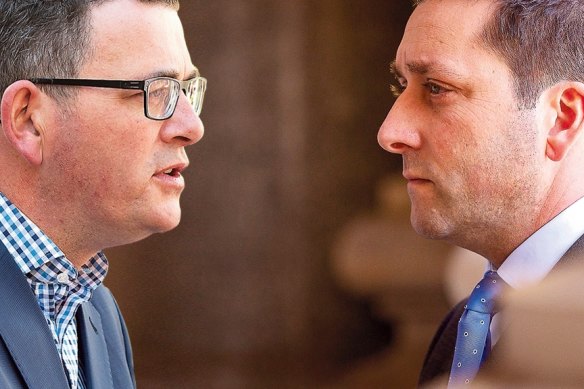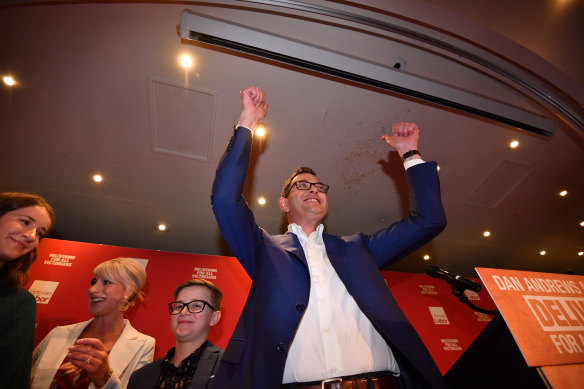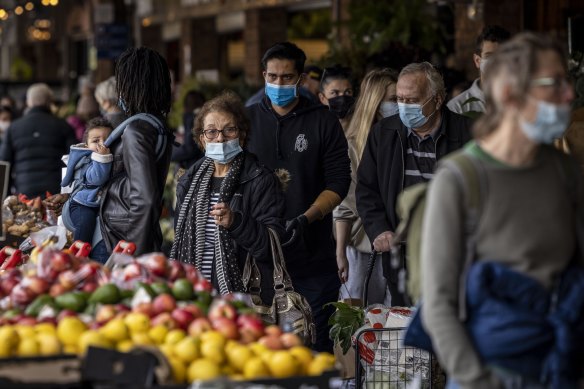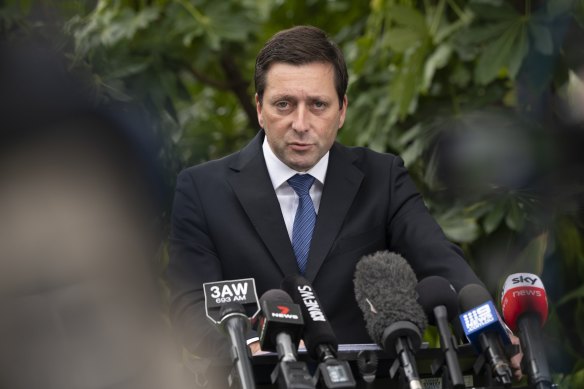- Analysis
- Politics
- Victoria
- Victoria votes
This was published 3 years ago
Fall in preference shifts pressure on to Labor
There is an increasingly outdated rule in Australian politics that political parties can't win elections with a primary vote below 40 per cent.
But a slow and steady decline in support for Labor, Liberal and National parties means this is no longer a hard and fast rule.

Victorian Premier Daniel Andrews and Opposition Leader Matthew Guy.Credit: Fairfax Media
In the 1980s, for example, more than 93 per cent of Victorian voters gave their first preference to a major party at the three state elections held that decade.
By 2014, that had dropped to 80 per cent. In 2018, it slipped further to 78 per cent.
The latest survey by Resolve Political Monitor conducted for The Age indicates that trend will continue.
According to the data Labor’s primary vote has fallen from 43 in 2018 to 38 per cent, and the Coalition's vote sits at 34 per cent.
This suggests that almost 30 per cent of Victorian voters are willing to give their first vote to a minor party or independent candidate, making their second preference more important when it comes to who governs.
Traditionally, Labor has received the lion’s share of preference flows, with upwards of 80 per cent of Greens voters preferencing the ALP over Coalition.
So, with the Coalition trailing Labor on its primary vote and preferences favouring Labor, why were so many Liberal MPs buoyed by the latest poll?
Firstly, pollsters and campaign strategists traditionally use preference flows from the last election, in those case 2018, to help determine which party is in the box seat.

Premier Daniel Andrews and his family celebrate Labor’s election win on November 24, 2018. Credit: Joe Armao
With a primary vote of 38 per cent, pollsters put the Andrews government in an election-winning position of 56:44 on a two-party vote based on 2018 preference flows.
But both sides agree that next year’s preference flows are unlikely to mirror those of 2018. A pandemic, a polarising Premier and an apparent jump in support for the independent and minor parties suggests Victorians are starting to look for an alternative.
Using a more modest (and realistic) preference flow formula, Labor would win the election in a two-party preferred position of 54:46 or tighter depending on which side you talk to.
Party insiders and MPs also believe the latest result inflates the vote of the independents. While they acknowledge that major parties are on the nose, they point to a mid-election cycle trend that sees voters snub the major parties because they are simply fed up with politics and don’t want to reveal who they will vote for.

While individual polls should be taken with a grain of salt, there is a story to tell about the mood of voters in Victoria.Credit: Wayne Taylor
It was a trend Labor witnessed going in to the 2018 election.
As they did in 2018, many of those voters will come back to the major parties, until then, they remain ripe for the picking.
While individual polls should be taken with a grain of salt, there is a story to tell about the mood of voters in Victoria.
The biggest movement in this poll was in the preferred premier stakes. The return of Matthew Guy as leader of the parliamentary Liberal Party has halved the gap between the leaders of the state’s two major parties.

Matthew Guy’s return has halved the gap between the leaders of the state’s two major parties.Credit: Chris Hopkins
While Guy hasn’t been able to shift the Coalition's primary vote, the Liberal Party has so far avoided a transaction cost for swapping leaders mid-term. The small slip in the Coalition’s primary was instead due to a loss of support for the National Party.
Insiders strongly suspect this is linked to the brand damage Barnaby Joyce and the federal National Party inflicted in Canberra as the party squabbled over a net zero emissions target.
The drop in support for Andrews also supports a trend campaign strategists have known for a while; voters aren’t necessarily turning off the government, but many are fed up with the Premier.
With more voters now willing to look at Guy as a viable alternative, there is a risk that Labor’s primary vote could fall further in the next 12 months.
The dip in support for Labor also coincided with the state opening up, not closing down. It was particularly high among voters in their late-30s to early-50s who seemed prepared to vent their anger after months and months working-from-home and remote schooling.
While nothing in the latest voter survey suggests the Coalition will win next year’s election, it has offered the Coalition a rare window of opportunity.
Labor doesn't have the luxury of ignoring its dwindling primary vote especially when Andrews remains on the nose.
A year out from polling day, Victorians are showing they are willing to at least look at an alternative leader. A trend Labor would be remiss to ignore.
Annika Smethurst is state political editor.